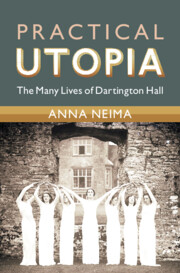Summary
For the Elmhirsts, the arts offered a source of unity in an age of division and fragmentation, and they initiated diverse programmes at Dartington in drama, dance, music, arts education, film, crafts and the visual arts to further their unitive vision. The tensions that arose in the course of these activities echoed wider debates about the role of creativity in society: between modernist ‘formalist’ art – eschewing any social or historical meanings – and avant-garde ‘functionalism’ that worked to restore the integration of art and life; between the craftsman-controlled, unified production process and more commercially-oriented notions of the relation between art and industry; and over what type of community art was intended to unify – the local ‘folk’, the nation, or a harmonious, global society. The difficulty in finding a coherent policy for the arts meant that the Elmhirsts gradually gravitated away from making the estate itself a replicable model for how the arts should unite society, and towards it contributing to government-led initiatives instead.
Keywords
- Type
- Chapter
- Information
- Practical UtopiaThe Many Lives of Dartington Hall, pp. 145 - 200Publisher: Cambridge University PressPrint publication year: 2022

